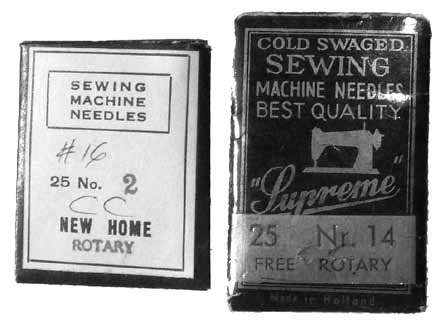
Needles for a Free Rotary CC (right) – alongside those for a New Home Rotary in size 2; or, as the dealer noted, Free CC needles in (Singer) size 16. They are the same.
Sharp Practice
One of the problems of maintaining our old machines is keeping them supplied with needles. Many sewing machine shops and repairers carry some old stock and random supplies of old needles regularly appear on specialist sites and the online auctions, but the classifications – which varied from manufacturer to manufacturer – now seem very confusing.
Some sewing machine manufacturers made and classified their own needles; Singer is a prime example, whose system survives to this day. With such a huge range to service, it made commercial sense. Specialist needle makers would supply needles for the smaller companies and a market soon grew for foundries to sell their own versions of proprietary needles.
The Boye Company of Chicago is probably best known in this field; with its counter-top carousel, dispensing large wooden tubes of tiny steel needles. The system was simple: you compared your old needle with the chart on the lid, noted the Boye 'number' it provided and the dealer sold you the appropriately numbered needle tube.
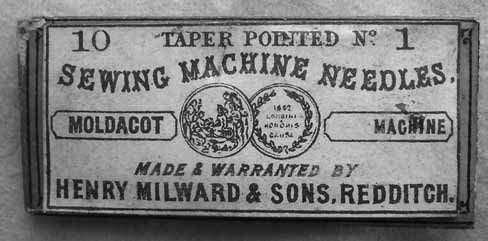
Rare needles for the Moldacot
There's no apparent logic to Boye's numbering. While it extends from 2 to 27 (mostly even numbers; odd numbers were usually shuttles), there are many gaps and, inexplicably, the numbers 2½ and 20½. And while the system catered for many machines, only a comparative few were actually named (typically 200). Perhaps Boye wanted everything self-contained and printable on the lid of the display dispenser.
At the other end of the scale is the Bryson catalogue – with its magnificently 'homemade' illustrations – that promised to cover 8,000 named machines with just eight needle classes.
Anomalies abound between the systems. What Singer calls 20x1, for example, Boye subdivides into four different categories. Their tube numbers 4, 12, 14 and 21 all appear to contain identical needles (20x1). Indeed, their no. 4 is further divided into further separate classes by some manufacturers.
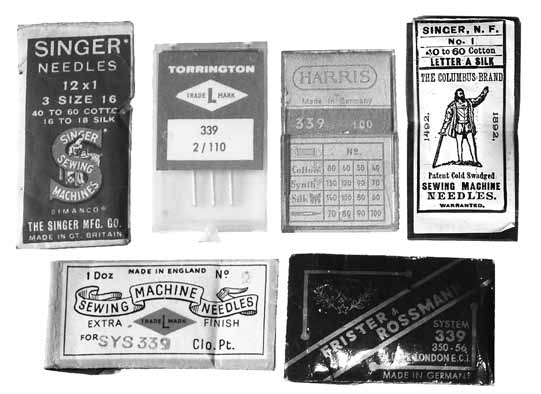
Labelled European 339 and 'Singer N.F.', but they all contain 12x1 needles.
Brewer's catalogue referred you to another needle comparison chart (drawings) with its own numbering. In common with many needle lists, Brewer also described its needles by the names of the original manufacturer or machine; hence names like "Free Rotary", "Household", or "Singer High Arm".
Some, like the Free S.M. Co., for example, packeted needles made by Torrington as their own. Free's system was again different (double letters: CC, DD, etc.). It used fewer classifications but the list of machines they fitted mainly referred to Free and New Home models.
I am intrigued to know how satisfactory the 'comparing an old needle with a drawing' method was in practice. At first glance it looks wide open to error yet Boye – amongst many others – didn't see any need to change it.
I have been careful to avoid the word 'size'. Each of the above classifications, with their myriad 'names', would have been available in a range of diameters. These, too, can be confusing as manufacturers insisted on using their own 'sizes', but I'll return to those in a later issue.
Modern needle catalogues, from Muva, Singer, Beka etc., tend to contain essential needle measurements (usually shank diameter, butt-to-tip and butt-to-top of eye) for each class but, amongst the many old lists I've seen, only Singer seemed to quote any measurements.
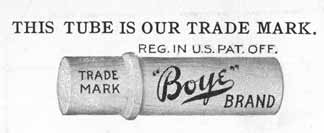
With the aid of Graham Forsdyke's archives and an unnecessarily tall pile of my own needle catalogues, I have now compiled a comprehensive list of all the machines (6,000+) identified by the available lists; each with the equivalent needle systems that are said to fit. It's 100 pages long – free - and downloadable from ISMACS Needle List
Hopefully, it should identify whether that old packet of needles is going to be useful.
John Langdon
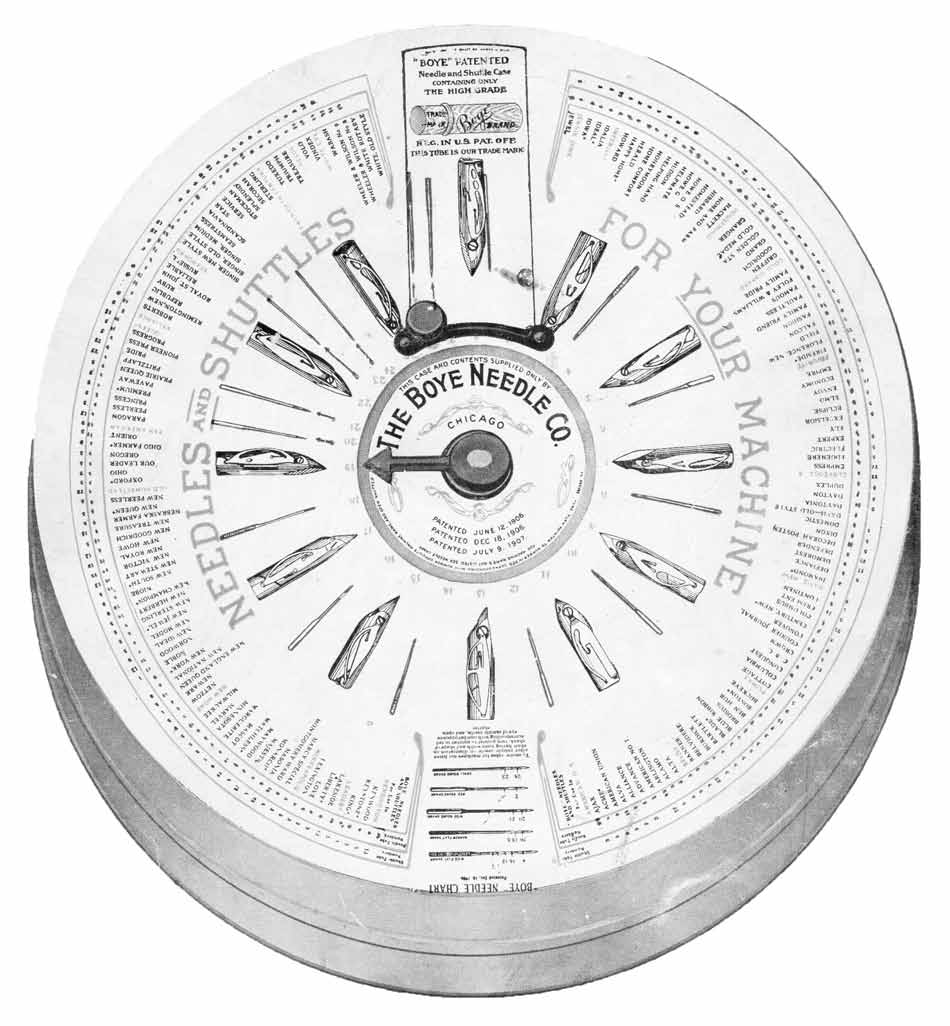
The Boye display carousel; point the arrow at the needle number and your tube is presented.
DBx1
This is a very common industrial needle which means it has a round shank. It's similar enough in most dimensions to work with a lot of German transverse shuttle machines, originally designed to take a 12x1; though the shank may be too wide to fit in a Singer NF (Model 12) needle clamp.
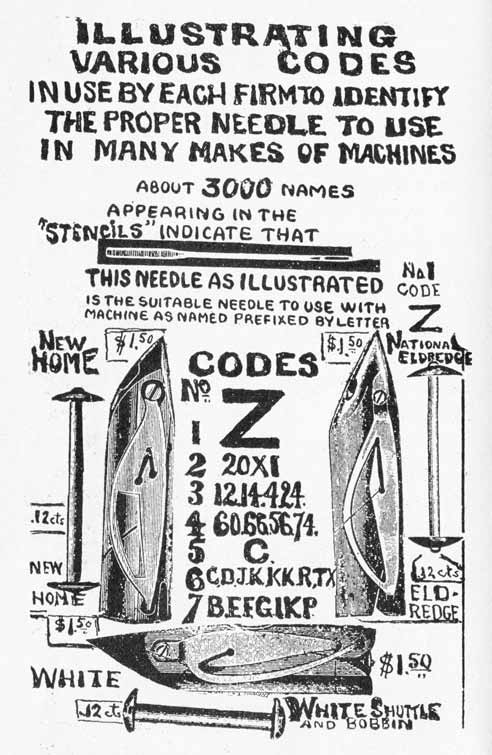
Bryson's ID chart for 'Z' needles (20x1) from their catalogue. Rival manufacturers' codes are listed under the large Z, showing further sub-divisions. Like Boye, Bryson included shuttles and bobbins in their display case.
The digital micrometer paradox: needles of the same size seldom are.
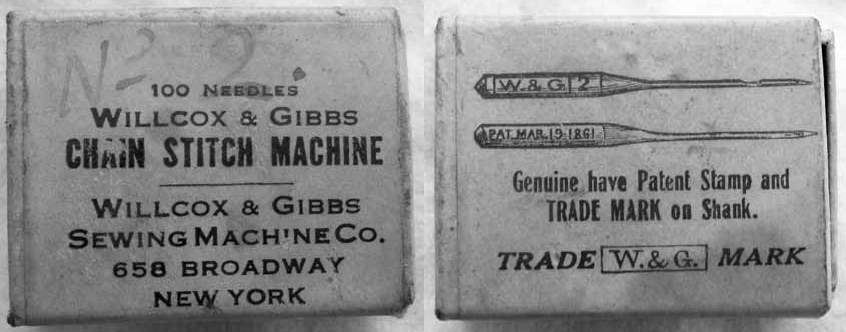
Willcox & Gibbs
For comprehensive information on Wilcox & Gibbs needles (Boye 20½; Schmetz WY 502), where to source them and how to translate old W&G sizes into recognisable, modern sizes, visit: Chain Stitch Sewing Machines: Willcox & Gibbs Needles






